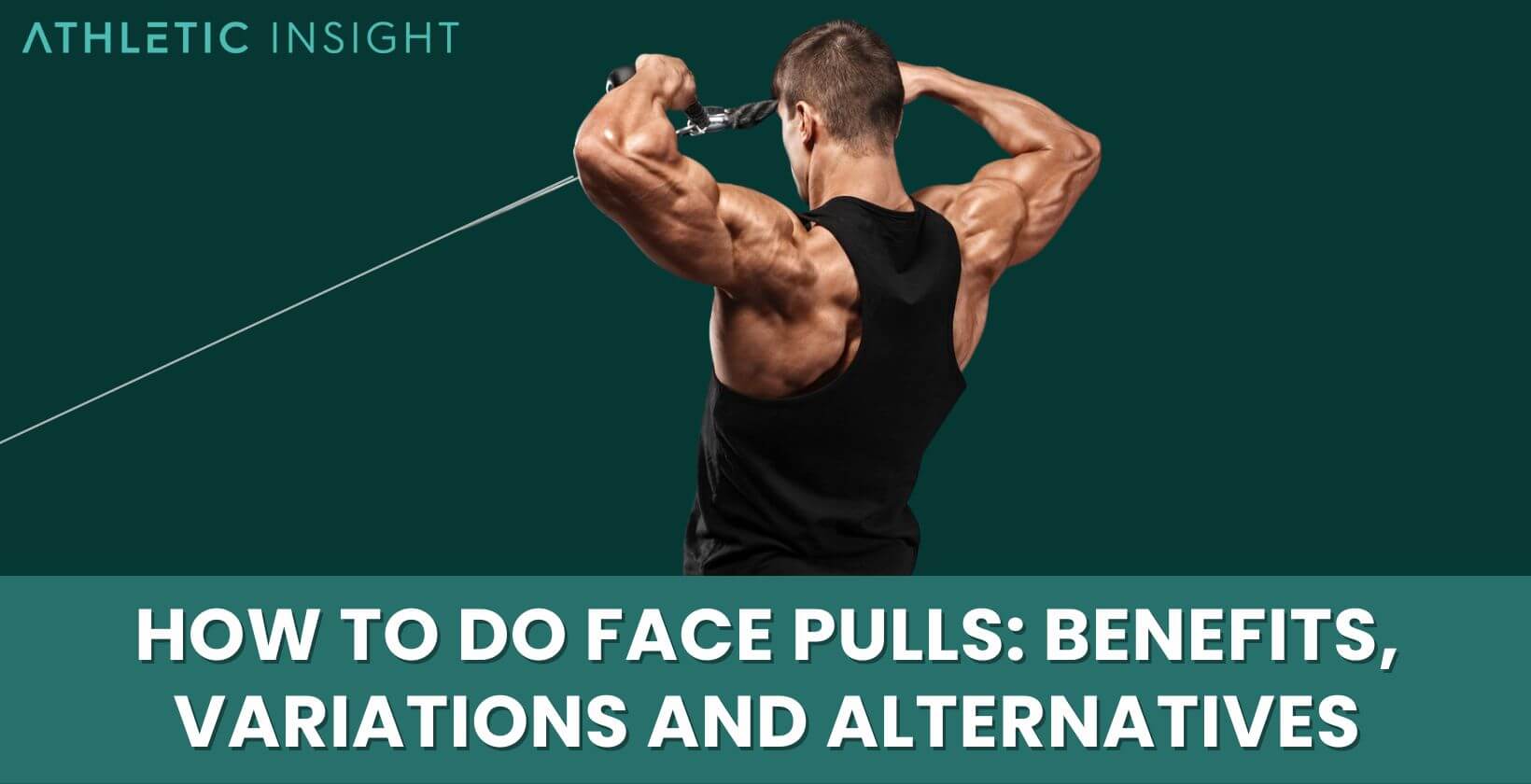At first glance, the face pull might look like a cable row gone awry, but it’s actually a powerhouse exercise for sculpting your rear delts and bolstering shoulder health. Unlike most workouts, the face pull zeroes in on the rotator cuff, a crucial muscle group for shoulder stability. This unique focus makes it a key player in building resilient, injury-resistant shoulders.
Jump into the world of face pulls to discover how this exercise can transform your fitness routine, from understanding its benefits to mastering the perfect form. Get ready to unlock the secrets to stronger, more mobile shoulders with the face pull.
What Is A Face Pull?
The face pull is an exercise using a resistance band or cable system, aimed at strengthening shoulder and upper back muscles. Performed by pulling the resistance towards the face with high elbows and outward shoulder rotation, it specifically targets the posterior shoulder muscles, enhancing stability and posture.
This movement emphasizes scapular retraction and external rotation, making it beneficial for improving posture, shoulder stability, and upper body strength. Due to its focus on often neglected posterior shoulder muscles, face pulls are popular in both rehabilitative settings and strength training programs to balance shoulder development and prevent injuries.
Which Muscles Do Face Pulls Work?
When you’re integrating face pulls into your upper body strength training regimen, you’re specifically targeting your rear delts, traps, rhomboids, and rotator cuff. These muscles play a crucial role in your overall shoulder strength and stability. By using a cable pulley machine with a rope attachment, face pulls become a versatile exercise that enhances your shoulder exercises arsenal.
Is Face Pull for Back or Shoulders?
Primarily, face pulls are a shoulder exercise designed to bolster the rear delts. However, they also significantly benefit your upper back muscles, including the traps and rhomboids. This dual effect ensures a balanced muscular development, reducing the likelihood of muscular imbalances.
Whether you’re aiming to perfect your power bench press or seeking to add depth to your lateral dumbbell raises, incorporating face pulls with a neutral grip or even an underhand grip can be a game-changer in your regimen. It’s not just about aesthetics; it’s about cultivating a foundation of strength that supports a variety of movements and reduces injury risk. Always remember, before attempting new exercises or if you have safety concerns or shoulder pain, consulting with an exercise safety expert is advisable.
How to Do Face Pulls?
When diving into your upper body strength training regimen, incorporating face pulls using a cable pulley machine and rope attachment can significantly boost overall shoulder strength. To truly unlock the benefits, it’s vital to nail the basics starting with grip and stance.

- Set up a cable machine or attach a resistance band at head height.
- Grip the handles or band with both hands, palms facing each other.
- Step back to create tension on the cable or band, standing with feet shoulder-width apart.
- Brace your core and slightly bend your knees.
- Start with your arms extended and pull the handles or band towards your forehead.
- As you pull, move your hands apart and rotate your wrists so your palms face forward at the end of the movement.
- Ensure your elbows remain high and parallel to the ground throughout.
- Squeeze your shoulder blades together as you pull the handles or band towards you.
- Slowly return to the starting position with arms extended.
- Repeat for the desired number of repetitions.
What is the Correct Grip For the Face Pull?
For the grip, you’ll want to adopt the unconventional yet effective underhand grip. This means positioning your thumbs backward, ensuring that the palms of your hands face upwards. This grip not only promotes external rotation of the shoulder but also minimizes injury risk. The underhand grip is essential for targeting the rotator cuff and rear delts efficiently. It’s a strategic tweak that sets the stage for safer and more beneficial exercise.
What is the Best Stance for the Face Pull?
The stance plays a pivotal role in the efficacy of face pulls. Opt for a square stance, characterized by both feet planted firmly on the ground, shoulder-width apart. This athletic stance regulates the amount of weight you can pull while preventing you from overloading to a degree that could degrade your form. If balance poses a challenge, a staggered position may be adopted as long as the hips and shoulders remain squared. This ensures the focus remains on the rear delts, upper back muscles, and rotator cuff without straining the lower back.
What are the Benefits of Face Pulls?
Face pulls, often done with a cable pulley machine and rope attachment, offer an array of benefits for your overall shoulder health. Primarily targeting the rear delts, rotator cuff, and upper back muscles, these exercises are critical for countering muscular imbalances that commonly arise from your daily routines or other upper body strength training regimen.
By incorporating face pulls into your workout, you’re directly supporting shoulder stability. This stability is key not just for specialized exercises like shoulder presses or heavy power bench presses but also for everyday movements and activities. Also, face pulls help in enhancing your overall shoulder strength. Given their unique ability to engage muscles often overlooked by traditional shoulder exercises, they serve as an essential exercise for developing a well-rounded fitness approach.
Whether you’re using a cable machine, resistance bands, or opting for dumbbell exercises in a seated position, the versatility of face pulls allows them to be seamlessly integrated into your regimen.
What are the Common Mistakes of the Face Pull?
When diving into your upper body strength training regimen, face pulls using a cable pulley machine or resistance bands are a staple for enhancing overall shoulder strength. Yet, without the right technique, you’re risking more than just missing out on the benefits. Three common errors often stand between you and the gains you’re aiming for.
Firstly, too much momentum is a frequent misstep. If you find your body rocking back and forth or letting your biceps hijack the movement, you’re not alone. This undermines the exercise’s purpose to fortify your rear delts, rhomboids, and rotator cuff by sidelining the targeted muscles.
Another pitfall involves the incorrect grip. Many lean on a pronated grip, but optimizing results calls for a neutral or underhand grip. This adjustment ensures the focus remains on the intended muscle groups.
Finally, standing improperly can shift the exercise’s impact. Whether you’re positioned before a cable machine with a rope attachment or anchoring a resistance band, your stance should be stable. A staggered position might seem advantageous, but maintaining both feet firmly on the ground, shoulder-width apart, guarantees the balanced engagement of your upper back muscles.
Remember, refining your face pull technique curtails injury risk and bolsters shoulder stability. For personalized guidance or if you’re exploring shoulder pain, reaching out to a healthcare provider or an exercise safety expert is wise.
What are the Variations of Face Pulls?
When it comes to shoulder exercises that boost your overall shoulder strength and tackle muscular imbalance, face pulls are a top-tier choice. Different face pull variations allow you to integrate them seamlessly into your upper body strength training regimen, regardless of the equipment you have access to.
Cable Face Pulls are perhaps the most popular variant. By using a cable pulley machine with a rope attachment, you can achieve a consistent tension throughout the exercise, fine-tuning the focus on your rear delts, rhomboids, and rotator cuff. This version lets you adjust the weight easily, accommodating both beginners and those at an intermediate level.
If you don’t have access to a gym or prefer a home workout, Resistance Band Face Pulls are an excellent alternative. All you need are resistance bands and something stable to anchor them to. While the resistance curve differs from that of a cable machine, this variant still effectively targets your upper back muscles, promoting shoulder stability and reducing injury risk.
For those looking to challenge their stability further, Kneeling Face Pulls add an extra layer of difficulty. By performing the exercise in a kneeling position, you prevent the use of momentum, thereby increasing the exercise’s effectiveness.
What are the Face Pulls Alternatives?
Face pulls are a game-changer for your shoulder health and overall upper body strength. However, it’s always smart to diversify your workout. If you’re looking to mix things up or need alternatives due to equipment availability, consider exercises like reverse flys, band pull-aparts, and external rotation exercises. These moves similarly target your rear delts and rotator cuff, contributing to a balanced and strong shoulder complex.
Remember, variety in your training can prevent overuse injuries and keep your workouts fresh and engaging. Just like with face pulls, focus on form and consult professionals if you’re unsure about a new exercise. By incorporating these alternatives alongside face pulls, you’ll ensure your shoulders are not only powerful but also protected from injury. Keep pushing your limits safely, and you’ll see the benefits in no time.
Key Takeaways
- Face pulls are essential for targeting the rear delts, traps, rhomboids, and the rotator cuff, improving overall shoulder strength and stability, making this exercise a vital addition to any upper body strength training regimen.
- Using the correct grip and stance during face pulls significantly enhances their effectiveness. An underhand grip with thumbs positioned backward and a square stance with feet shoulder-width apart are recommended to minimize injury risks and target muscles accurately.
- Face pulls offer numerous benefits, including bolstering shoulder health, enhancing mobility, and correcting muscular imbalances that arise from routine activities or other exercises, thus supporting a well-rounded fitness approach.
- Common mistakes in performing face pulls, such as using too much momentum, the incorrect grip, or improper stance, can diminish their benefits and increase the risk of injury. Awareness and adjustment of these errors can lead to more effective workouts.
- Variations of face pulls, like cable face pulls, resistance band face pulls, and kneeling face pulls, enable integration into different workout settings, from gyms to home workouts, allowing for versatility in strengthening shoulder muscles.
- Consultation with healthcare providers or exercise safety experts is advised for personalized guidance and to prevent injuries, especially if there are any concerns or experiences of shoulder pain during workouts.
Frequently Asked Questions
Below are some of the frequently asked questions about the Face Pull exercise movement.
Are face pulls better than rows?
Face pulls and rows target different muscle groups and serve different purposes. While rows primarily focus on the middle and lower back, face pulls are more beneficial for the rear delts and rotator cuff. Both exercises are valuable for a balanced upper body strength training regimen.
Are face pulls a bad exercise?
No, face pulls are not a bad exercise. When performed correctly, they strengthen the shoulders, traps, rear delts, and rotator cuffs with minimal strain on shoulder joints. This makes them a safe and effective exercise for enhancing shoulder health and preventing injuries.
Do Face Pulls Work Your Back?
Yes, face pulls do work your back muscles. While the face pull is known as an excellent shoulder exercise, many consider it the best back workout if you prefer to use a cable system and are looking to change up your routine. For optimal hypertrophy results, keep the movement slow and be sure to squeeze (flex) your back muscles during the repition.
How to do face pulls correctly?
To perform face pulls correctly, stand facing the cable machine with your feet shoulder-width apart. Grab the rope with an overhand grip, pull the handles towards your forehead while keeping your elbows high and out to the sides. Make sure to squeeze your shoulder blades together at the end of the movement before slowly returning to the starting position.



